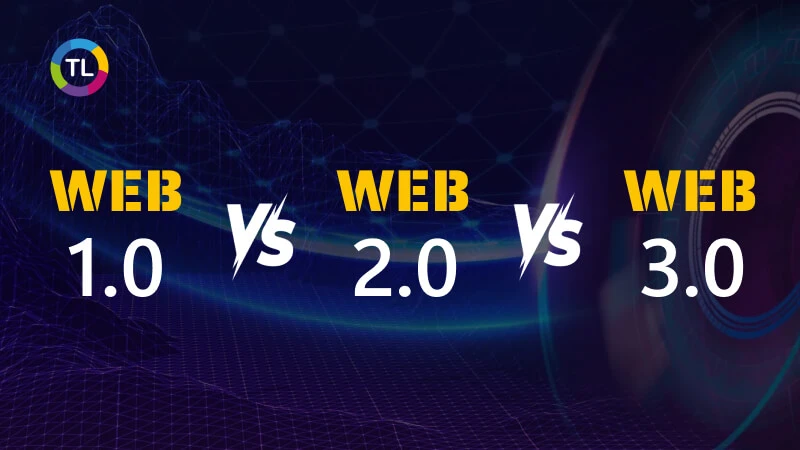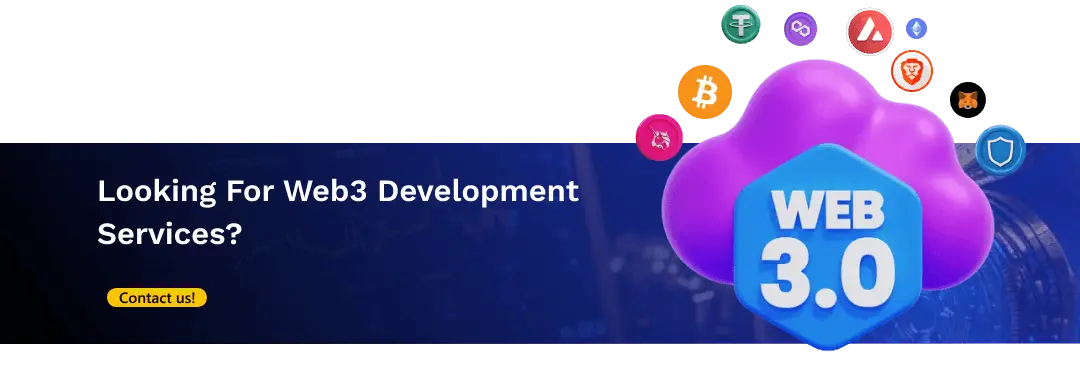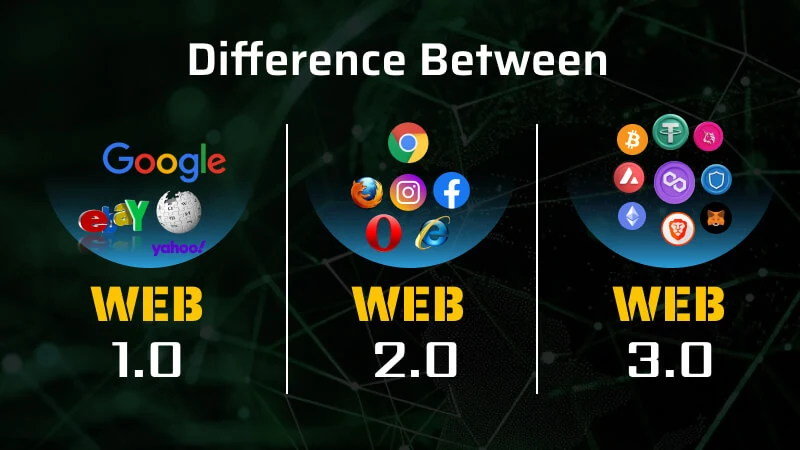In 1994, there were just about 10,000 websites on the internet. Fast forward to 2024, and that number has skyrocketed to 1.83 billion, with 203 million of them actively in use. This incredible growth reflects how far the web has come—from the early days of simple, static pages to today’s dynamic, user-driven platforms and decentralized ecosystems. But what does this evolution really mean for businesses, especially those exploring Web3 solutions?
If you’re wondering about Web 1.0 vs Web 2.0 vs Web 3.0, or asking yourself, “What exactly is the difference between these versions of the web?” — this blog will clarify it all.
Understanding these different phases is crucial for businesses to navigate and leverage the potential of Web3 technologies effectively.
Let’s break down the web’s evolution and why it matters for businesses looking to adapt and grow in the era of decentralization.
Table of Contents
What is Web 1.0?
Web 1.0, also known as the static web, was the first iteration of the internet. It was the most basic form, offering limited user interaction.
Features of Web 1.0:
- Read-only web: Users could only consume content, not interact with it.
- Static HTML pages: Websites were built using HTML and were non-interactive. These These
- No user-generated content: There was no way for users to contribute or change the content.
- Centralized content distribution: Content was owned and controlled by businesses.
Examples:
- GeoCities, Netscape, and early Yahoo are great examples of Web 1.0. These sites offered information but little in terms of engagement or interaction with users.
While Web 1.0 paved the way for the digital age, it was mainly a one-way street, where businesses published information, and users could only read it.
What is Web 2.0?
Web 2.0 marked the shift from static content to a more interactive and dynamic web. It gave users the ability to create, share, and engage with content, making the internet a more social and participatory space.
Features of Web 2.0:
- Read-write web: Users could not only read content but also contribute by creating posts, comments, and media.
- Dynamic content: Websites were no longer static and could change based on user interaction.
- Introduction of social platforms: Social media sites like Facebook and Twitter transformed user interaction.
- User-generated content: Platforms like YouTube and Wikipedia allowed users to share their own videos, articles, and knowledge.
- Centralized platforms: Large platforms controlled the data and interactions, leading to concerns about privacy and monopolistic control.
Examples:
Social media giants like Facebook, YouTube, Twitter, and the community-driven Wikipedia are prime examples of Web 2.0. These platforms encouraged participation, discussion, and engagement.
Impact on Businesses:
Web 2.0 transformed the way businesses interacted with their audience. It was no longer about simply presenting information but engaging with customers directly through social media, reviews, and community platforms. The rise of social media marketing allowed businesses to create campaigns that went viral, boosting brand visibility.
What is Web 3.0?
Now, we’re entering the realm of Web 3.0, the next evolution of the internet—often referred to as the decentralized web. Unlike Web 2.0, where data is controlled by large companies, Web 3.0 empowers users by giving them control over their data and assets.
Features of Web 3.0:
- Read-write-execute web: Not only users can read and contribute content, but they can also execute complex transactions, powered by smart contracts and blockchain technology.
- Decentralization: Instead of centralized servers, Web 3.0 operates on peer-to-peer networks like blockchain, ensuring transparency and security.
- User ownership: Individuals have full control over their data, as platforms are built to give power back to users.
- Blockchain technology: Web 3.0 is built on blockchain, which ensures that data and transactions are secure and immutable.
- Smart contracts and dApps: Decentralized applications (dApps) run on blockchain and operate without the need for intermediaries.
Examples:
- Ethereum, IPFS (InterPlanetary File System), and Decentralized Finance (DeFi) platforms are at the forefront of Web 3.0. These systems allow for trustless, secure interactions without the need for centralized authorities.
Impact on Businesses:
Web 3.0 is opening up new possibilities for business models. Tokenization, decentralized finance, and peer-to-peer transactions are revolutionizing industries. For businesses, this means exploring new ways to interact with consumers, ensuring data privacy, and leveraging blockchain for enhanced security.
Key Differences Between Web 1.0, Web 2.0, and Web 3.0
|
Category |
Web 1.0 |
Web 2.0 |
Web 3.0 |
|
Control |
Centralized, read-only |
Centralized platforms, read-write |
Decentralized, read-write-execute |
|
User Experience |
Static, passive |
Dynamic, interactive |
Personalized, immersive (AI, blockchain) |
|
Data Ownership |
Controlled by website owners |
Controlled by platforms |
Owned and controlled by users |
|
Technology |
Static HTML |
JavaScript, AJAX, social media |
Blockchain, AI, semantic web |
The Future of the Web: What to Expect
The future of Web 3.0 looks incredibly promising. As businesses increasingly shift towards decentralization, they will need to integrate AI, VR/AR, and blockchain technologies into their operations. The focus will be on creating seamless, secure experiences for users while maintaining their privacy and control over data.
For businesses, this means preparing for new opportunities in DeFi, tokenization, and blockchain-based services. The rise of metaverse platforms will also create new ways to engage consumers through virtual and augmented experiences.
In a world where control and data ownership are shifting back to users, businesses that can navigate this change will be better positioned for long-term success.
Use Cases of Web 3.0
Web 3.0 is transforming the way we interact with the internet, offering new opportunities across various industries. Here are some key use cases:
- Decentralized Finance (DeFi): One of the biggest Web 3.0 applications, DeFi enables users to access financial services like lending, borrowing, and trading without traditional intermediaries. Platforms like Uniswap and Aave allow peer-to-peer transactions using blockchain technology, making finance more accessible and transparent.
- Decentralized Applications (dApps): Web 3.0 promotes the creation of decentralized apps, which run on blockchain networks. These dApps can range from games to social platforms, offering users control over their data and content, unlike traditional centralized apps.
- Non-Fungible Tokens (NFTs): NFTs are reshaping digital ownership by allowing creators to tokenize digital art, music, and more. This gives artists direct control over their work, ensuring they get fair compensation for their creations.
- Supply Chain Management: Blockchain’s transparency makes it ideal for tracking goods and verifying supply chains. Web 3.0 enhances efficiency and accountability in industries like manufacturing, food, and pharmaceuticals.
Web 3.0’s decentralized nature is set to revolutionize everything from finance to entertainment, giving users greater control and fostering innovation across sectors.
Conclusion
In summary, the difference between Web 1.0, Web 2.0, and Web 3.0 lies in how they evolved from static, centralized systems to a decentralized web where users have more control. For businesses, especially those seeking Web3 development services, understanding these phases is critical for staying competitive and relevant in the digital age.
Interested in exploring Web3 solutions for your business? Technoloader can help you navigate the future of the web with innovative blockchain and decentralized technologies. Reach out to us today!
Quick Contact Us :
Call/whatsapp : 👉 +91 7014607737
Telegram : 👉 @vipinshar
Email : 👉 [email protected]
Frequently Asked Questions
- What is the key difference between Web 1.0, Web 2.0, and Web 3.0?
Web 1.0 was static and read-only, Web 2.0 introduced interactivity and user-generated content, while Web 3.0 is decentralized and powered by blockchain, allowing users to own and control their data.
- What are the main features of Web 1.0?
Web 1.0 consisted of static HTML pages, offered limited interactivity, and focused on information distribution without user-generated content.
- What industries can benefit from Web 3.0?
Industries like finance (DeFi), digital art (NFTs), supply chain management, and social platforms can greatly benefit from the decentralized nature of Web 3.0.
- How did Web 2.0 change the internet?
Web 2.0 enabled dynamic content, social interaction, user-generated content, and the rise of social media platforms like Facebook and YouTube.
- What makes Web 3.0 different from Web 2.0?
Web 3.0 is decentralized, leveraging blockchain technology to give users ownership of their data, enabling secure transactions without intermediaries.
- What are some popular Web 3.0 technologies?
Blockchain, smart contracts, decentralized applications (dApps), and NFTs are some of the key technologies driving Web 3.0.
- How does decentralization work in Web 3.0?
Web 3.0 uses blockchain technology to remove the need for centralized servers, allowing data and transactions to be handled by peer-to-peer networks.
- How does Web 3.0 impact data ownership?
In Web 3.0, users have full control over their data, unlike Web 2.0, where large platforms controlled and monetized user data.
- What are decentralized applications (dApps)?
dApps are applications that run on blockchain networks, allowing users to interact directly without intermediaries, providing more privacy and control.



